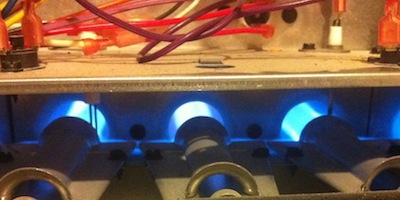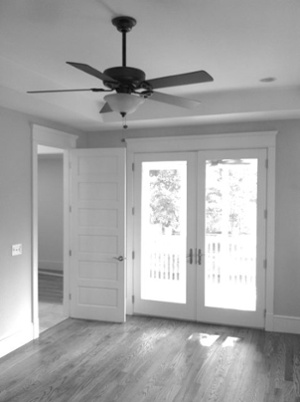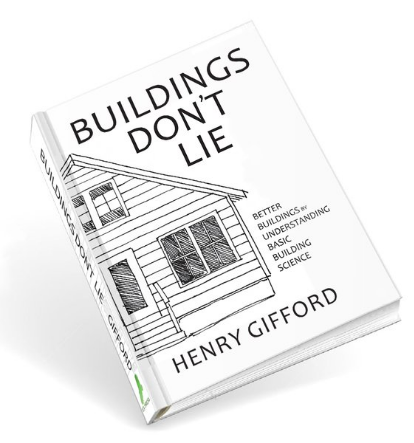Building Science and the Laws of Thermodynamics, Part 1

Today we take the next step on our stroll through the laws of thermodynamics. As you know from reading the first part of this series, the numbering of the four laws begins with zero, so here, in the second part, we discuss the first law of thermodynamics, which is actually the second of the four. And that’s why this is part 1. Got all that?
The first law of thermodynamics
Depending on how you’ve come to the field of building science, you may have encountered this law in the past. If you studied physics or engineering, you’ve no doubt seen all four laws of thermodynamics. If instead you arrived by a different route, this one may be new to you.
In thermodynamics, the first law is stated as a relation among heat, work, and internal energy. The relation between heat and work may seem natural to us now, but it was a big deal back in the early 19th century. Count Rumford started things off with his cannon barrel experiment, and then James Joule, Julius von Mayer, and Ludwig Colding refined the idea, proposing that the work is the mechanical equivalent of heat. Now students do this in their introductory physics lab.
We can do work and convert mechanical energy to heat. Think friction. We also can take heat and turn it into mechanical work. Think automobile engines. If the work and heat don’t equal each other exactly, the result is a change in internal energy. That’s a simplified version of the first law of thermodynamics.
But let’s forgo the formality and technical detail of the mathematical formulation of the first law and cut to the fundamental principle that’s important to building science:
Energy can be neither created nor destroyed.
Yep. The first law of thermodynamics is a formulation of the law of conservation of energy. It has many applications in building science.
The first law and heating with a furnace
Let’s begin with how we heat buildings. If it’s with a gas furnace, the fuel has a certain amount of chemical energy. When the gas gets to the burner and ignites (photo above), it changes form. The chemical reaction creates heat, which raises the temperature of the gases where the combustion occurs. Those exhaust gases travel through a heat exchanger, increasing the temperature of that hunk of metal. The blower then blows a separate stream of air over the outside of the heat exchanger, extracting heat from the metal and then sending it through the ducts to warm the building.
Every bit of chemical energy converted to heat ends up somewhere. Ideally, you want as much of that heat as possible to end up in your house, but not all of it does. Some goes up the flue with the exhaust gases. Better heat exchangers capture more of the heat for use in the house, but all furnaces send at least some heat up the flue. Another way you lose heat is when your ducts go through unconditioned space. The bottom line, though, is that if you burn 100 units of chemical energy, you get 100 units of heat.
The first law and ceiling fans
Here’s another way the first law works in buildings. Consider a ceiling fan. In summer, you turn it on to create a nice breeze blowing over your skin to cool you off. What happens with the energy is that you’re actually heating up the room.

In this case, the incoming energy is electrical. The fan motor converts it to mechanical energy, the moving fan blades. But it doesn’t do convert electricity to motion at 100% efficiency. The wires in the fan motor have resistance, which creates some heat. Thus, some of the electricity is turned into heat right away. The rest of the electrical energy becomes mechanical energy, but even that too eventually becomes heat. So all of the electricity you use to run the ceiling fan actually heats up the room, which is why it does no good to leave them on when no one is there to feel the breeze.
Follow the energy!
In his book, Buildings Don’t Lie, Henry Gifford advises readers on how to use the first law of thermodynamics to understand energy saving features and to sniff out scams. For a product to save energy, he says, you have to know where the energy is going before using that product. Insulation, for example, reduces the amount of heat lost from a building in winter, with a corresponding reduction in the amount of heat you have to add to the building to maintain comfort. If you can’t identify clearly the path of energy conversions, Gifford says, “the proposed energy-saving measure should be viewed with skepticism.” (And there’s a lot more than this in the book. You should get yourself a copy.*)
Take Amish fireplaces, for example. Although they’re marketed as great energy savers, there’s nothing about them that saves energy over any other electric resistance heater. They all convert electricity to heat at 100% efficiency (like a ceiling fan). The only way to save energy with a space heater is if you turn off the heat in the rest of the house and huddle near it all day.
The power of the first law of thermodynamics
The first law of thermodynamics packs a wallop. It allows us to quantify what happens as energy moves around, converting among various forms. We can make better decisions through careful analysis with the first law. But, it’s not enough. As it turns out, the first law is OK with a whole lot of things that just never happen. And that’s why we need the second law, the subject of the next article in this series.
Allison Bailes of Atlanta, Georgia, is a speaker, writer, building science consultant, and founder of Energy Vanguard. He is also the author of the Energy Vanguard Blog and is writing a book. You can follow him on Twitter at @EnergyVanguard.
Other Articles in This Series
Building Science and the Laws of Thermodynamics, Part Zero
Building Science and the Laws of Thermodynamics, Part 2
Building Science and the Laws of Thermodynamics, Part 3
Related Articles
Why Doesn’t Heat Flow Backwards?
How the Heck Does a Heat Pump Get Heat from Cold?!
What IS Heat Anyway? – Building Science Fundamentals
* This is an Amazon Associate link. You pay the same price you would pay normally, but Energy Vanguard makes a small commission if you buy after using the link.
NOTE: Comments are moderated. Your comment will not appear below until approved.
This Post Has 9 Comments
Comments are closed.


Thanks Allison – brings back
Thanks Allison – brings back memories. You gotta love this stuff, right? I mean, any degree that gets you a MATH degree without even asking for it – we must be gluttons for punishment, right? Of course it’s probably also that same thinking that makes it tough for me to get along with builders and HERS raters who insist on doing it their way, because that’s the way its always been done.
I have met people, including
I have met people, including some engineers, who do not believe that the First Law of Thermodynamics (conservation of energy) is truly a LAW of nature. (Technically it isn’t, since nuclear reactions result in a conversion of mass to energy, but let’s limit ourselves to non-nuclear processes for this discussion.) These non-believers think that it only applies to “ideal” processes and not the “real world”. That is simply not true and no credible evidence has ever been shown that disproves this “law”. My reply to these people is that I have used the 1st law throughout my career and it has served me well.
Allison, can I add another
Allison, can I add another quiz?
For a given amount of natural gas (assuming complete combustion), which device provides more heat to a space: 1) an unvented heater; or 2) a vented furnace with an AFUE of 95%?
Sure, Roy. But this one’s a
Sure, Roy. But this one’s a lot easier than your last one.
We shall see if it is easier.
We shall see if it is easier.
From a “building physics”
From a “building physics” perspective I would say the unvented heater adds more heat, as although it draws combustion air from the space it is heating, it vents directly into the space, therefore of its own accord is not accelerating negative building pressure in lower regions of the structure on a cold day. This is assuming, however, that the 95% AFUE furnace draws combustion air from the space also, coupled with heat lost up the flue via venting the heat exchanger and from air drawn from the space.
That said, strictly by itself a 95% AFUE furnace is a condensing furnace, meaning there is a release of heat when the flue gases are condensed. However it isn’t a 100% recovery; every heat exchanger has inherent inefficiencies. Air passing through the condenser fins will have a measure of bypass factor built in per unit of air volume. Motor heat from the blower motor cannot be factored here as the question posed is for a given unit of natural gas with a given heat content per unit when 100% combustion is assumed. Not yet considered is whether this furnace has ductwork passing through unconditioned spaces or not, and amount of duct leakage into or from said spaces. Nor where the furnace itself is located; attic? Attached garage? Within the conditioned space?
Cameron brings up a lot of
Cameron brings up a lot of good “second-order” effects, but the main effect is that unvented heaters do not recover any heat from the water vapor in the combustion gas (unless it condenses on the windows), but a 95% efficient (AFUE) vented furnace gets about 5% more heat than a vented heater from the water vapor that condenses in its secondary heat exchanger. If you could make a 100% AFUE furnace, it would produce about 9% more heat than a common (non-condensing) unvented heater. The unvented heater manufacturers claim 99.9% efficiency, but that is based on the lower heating value of the fuel which does not include the heat of condensation of the water vapor in the combustion products. Vented furnace efficiencies (AFUE) are based on the higher heating value of the fuel which does take the heat of condensation into account and is thus about 9% higher.
Latent heat is “heat” and you
Latent heat is “heat” and you might convert it back to sensible in your ERV, dehumidifier or less use of a humidifier. Account for this and unvented “provides more heat”.
Interesting, I am working on
Interesting, I am working on electrically powered boilers since last ten years & have generated twice the quantity of steam than is mentioned in the Heat and Power equivalents, my fuel to steam ratio is around 85 to 90 %, certified, this was possible by cancelling, containing, & controlling entropy, has anyone been working on entropy anywhere to generate twice?